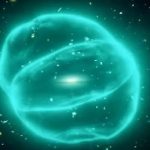Key Takeaways:
- Astronomers discover J2157, an extraordinary supermassive black hole (SMBH) with 34 billion times the Sun’s mass, making it the largest known quasar and fastest-growing black hole.
- This SMBH, observed 12.5 billion light-years away, challenges previous understandings of black hole growth and existence in the early Universe.
- J2157’s mass is 8,000 times greater than the Milky Way’s central black hole, providing unique insights into early cosmic evolution.
- The discovery offers a rare opportunity to study how SMBHs influenced galaxy development and the broader cosmos soon after the Big Bang.
- Ongoing research aims to uncover more ancient black holes at the hearts of early galaxies, shedding light on their formation and impact.
In a cosmic revelation, astronomers have unveiled an astonishing supermassive black hole (SMBH) named J2157, which possesses a mass equivalent to a staggering 34 billion suns. This gargantuan entity not only reigns as the largest observed quasar but also stands as the fastest-growing black hole known to science. The groundbreaking study, led by Dr. Christopher A. Onken of the Australian National University, was a collaborative effort with experts from the Research School of Astronomy and Astrophysics, the Center for Gravitational Astrophysics, the European Southern Observatory, and Steward Observatory.
J2157 was initially identified in 2018, its brilliance attributed to the presence of an SMBH at its core. Importantly, the researchers were able to dismiss the possibility that this luminosity was a consequence of gravitational lensing, dispelling intervening galaxies’ role in magnifying J2157’s radiance. The latest study harnessed data from the European Southern Observatory’s Very Large Telescope in Chile, unveiling a revelation that startled even the experts.
The black hole’s mass dwarfs that of the Milky Way’s central black hole by a staggering factor of 8,000. To reach such a colossal size, the Milky Way’s black hole would have to consume a staggering two-thirds of all stars in our galaxy. This finding is even more remarkable considering it offers a glimpse into the universe’s infancy, occurring a mere 1.2 billion years post-Big Bang, when the cosmos was still in its infancy, representing less than a tenth of its present age.
While J2157’s predilection for consuming stars in its galaxy’s central region was previously known, the astounding revelation lies in its status as the fastest-growing SMBH within a mere 1.2 billion years post-Big Bang. Dr. Fuyan Bian of the European Southern Observatory emphasizes the profound implications of this discovery, shedding light on black hole feeding dynamics. Furthermore, J2157 offers a unique opportunity to probe the early Universe’s evolution and its influence on galaxies’ development.
This colossal black hole serves as a window into the early cosmos, unraveling mysteries of black hole evolution and their profound impact on the universe’s formation. The researchers, undeterred by this monumental discovery, are fervently searching for additional ancient black holes nestled at the hearts of early galaxies, eagerly anticipating further revelations about their formation and cosmic influence. This profound milestone underscores the accelerating pace of cosmological discovery, buoyed by advancements in telescope technology, artificial intelligence, and global data sharing, setting the stage for unprecedented revelations about the universe’s ancient past.


